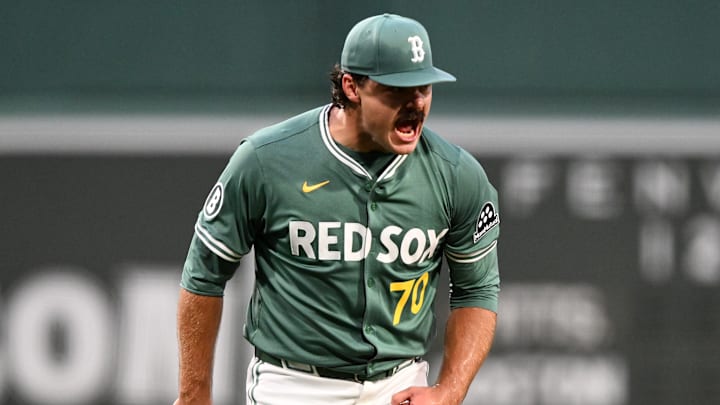Historically, the Boston Red Sox have not been noted for their ability to churn out viable major league starting pitchers. Since the start of the 2020s, this tendency has slowly turned, as first Tanner Houck and then Brayan Bello made themselves long-term assets to the rotation.
Now, the perennially pitching-poor Red Sox have found a veritable levy of prospects with genuine potential to stick around for the rest of the decade, if not longer. Among the 26-and-younger crowd stand Bello, ace Garrett Crochet, Kyle Harrison, and rookies Hunter Dobbins, Richard Fitts, Payton Tolle, and Connelly Early, with more apparently on the way. For the first time in recent memory, a fan can reasonably ask whether this is the best young pitching corps in the history of the franchise.
The last time the Boston Red Sox came up with quality pitching was between 2005 and 2009, when the Red Sox debuted Jonathan Papelbon, Jon Lester, Clay Buchholz, Justin Masterson, and current head of baseball operations Craig Breslow. They also acquired Daisuke Matsuzaka and Josh Beckett on the eve of their age-26 campaigns.
Papelbon is the best closer in franchise history, topping the franchise list with 219 saves. Lester won 200 games in the majors, including 110 for the Red Sox. Buchholz made two All-Star teams in a thirteen-year career, though he was plagued by year-to-year inconsistency. Masterson was a workhorse for Cleveland in the early 2010s before injuries curtailed his career.
The Age of the Rocket
In the early eighties, the Red Sox developed their greatest pitching corps between the First World and Second Gulf Wars: John Tudor (1979), Bruce Hurst (1980), Bob Ojeda (1980), Oil Can Boyd (1982), Al Nipper (1983), and finally the greatest of them all, Roger Clemens (1984).
Of these, Nipper was the weakest, a decent fifth starter from 1984 to 1987, making 105 starts with a 4.67 ERA (92 ERA+). Ojeda had his best season for the 1986 Mets, but the southpaw junkballer had three straight solid seasons for his original team starting in 1983 (82 starts, 106 ERA+). Tudor made his mark as the ace of Whitey Herzog’s mid-eighties Cardinals, but he spent the first five seasons of his career in Boston (94 starts, 108 ERA+) before being traded to Pittsburgh in December 1983.
Boyd is best remembered for his moniker and sometimes explosive temperament, but between 1983 and 1986, he gave the Red Sox 104 starts with an ERA of 3.84 (110 ERA+).
If not for Clemens, Bruce Hurst would easily rank as the best homegrown starting pitcher between Mel Parnell and Jon Lester; from 1983 to 1988, he made no less than 25 starts each year and never pitched worse than league average (186 starts, 108 ERA+). His 88 victories in a Red Sox uniform remain seventh among lefthanders, one fewer than Babe Ruth.
The Rocket, of course, is arguably the greatest pitcher in Red Sox history. His 192 wins are tied with Cy Young for most in Red Sox history, as are his 38 shutouts. Besides complete games, Clemens and the late Tim Wakefield account for the franchise lead in every counting statistic for starting pitchers.
What makes this cohort even more remarkable is the fact that they are the only such class across a period constituting most of the franchise’s history (1915-2005). Occasionally, the Red Sox could come up with Sparky Lyle and Bill Lee or Mel Parnell and Tex Hughson, and pitchers like Jim Lonborg and Boo Ferriss would have a big year or two, but never did they come close to matching the early eighties in quality and quantity.
Bill Carrigan’s Babes
Finally, we turn to undoubtedly the most accomplished clutch of young pitchers the Red Sox have ever accumulated. Between 1912 and 1918, the Olde Towne Team won four World Series, largely thanks to a staff collected and nurtured by catcher-manager Bill Carrigan. This included:
Smoky Joe Wood, winner of 34 games in 1912 and a Boston career ERA of 1.99 (149 ERA+).
Rube Foster, who won 58 games in five seasons with a 2.36 ERA (116 ERA+).
Dutch Leonard, holder of the single-season ERA record with a 0.96 mark in 1914. His 90 wins rank fifth best for southpaws in franchise history.
Carl Mays, winner of 207 games across 15 major league seasons, though he is best known for delivering the pitch that killed Ray Chapman in 1920.
Ernie Shore, who won 58 games in four seasons and posted a 2.47 ERA (114 ERA+).
Sad Sam Jones, winner of 229 contests in 22 years as a major leaguer.
Hall of Famer Herb Pennock, though he did not pitch a full season until 1919 and did his best work with the mid-1920s Yankees.
And then there’s Babe Ruth. Ruth won 89 games in Boston, posted a 2.19 ERA (125 ERA+), and led the American League in 1916 with a 1.75 ERA. He also put up 29 and 2/3 scoreless innings between the 1916 and 1918 World Series, winning all three of his starts.
Conclusion
It is unfair to compare this largely unproven corps to what we know the Lester, Clemens, and Ruth cohorts achieved. But certainly, given what the current class has already accomplished, two proven starting pitchers already provide a solid foundation towards a historic era of Red Sox baseball.
